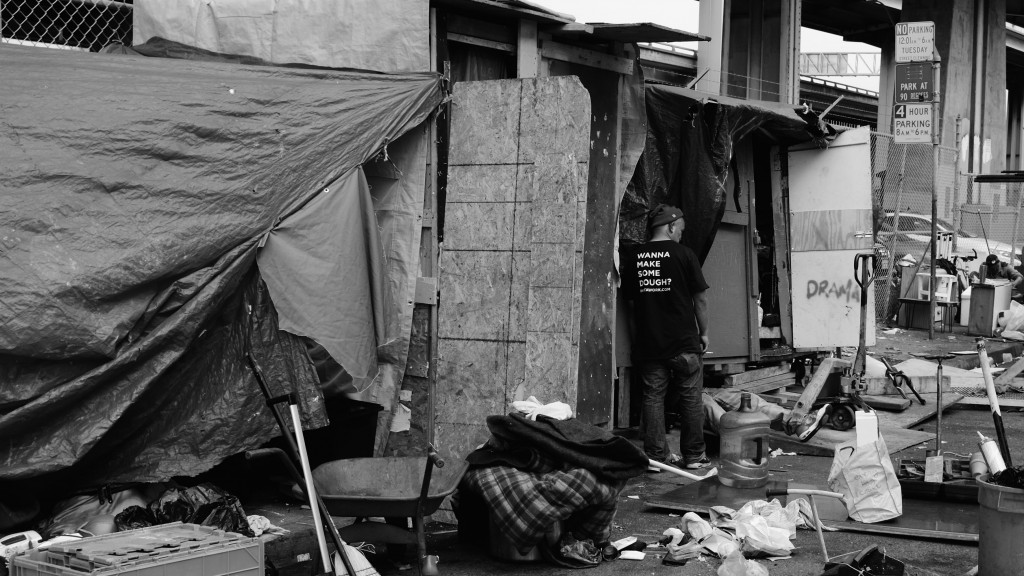
[dropcap letter=”W”]hen the eviction notices appeared one morning in early December, the roughly three dozen residents of Box City, a shanty village on the outskirts of San Francisco’s revitalized Mission Bay District, had a choice.
The thin slips of paper stapled to the four-by-eight-foot plywood structures by the city’s new Encampment Resolution Team laid out the options: they could take an offer for 30-day shelter at the Mission Navigation Center, or they could clear out.
On the one hand, the Navigation Center promised hot showers, a comfortable bed and a chance to connect with case managers, health services and the coveted housing pipeline. On the other, what would happen when 30 days were up? Where would they go without the sanctuary of their shelters, possessions, and the tight-knit community that looked out for them in a climate of fear and desperation?
In Box City, Roland, a 44-year-old Filipino man with a shaved head and hoop earring, had finally found a place he felt secure enough to settle. At night, he’d roam the streets in search of glass and plastic bottles to recycle – his main source of income. Most of the money would be wired home to the Philippines to help pay for his sister’s dialysis treatments. During the day, he’d sleep and mingle with his neighbors.
The experience was a far cry from the other camps Roland had passed through, where he lived under constant threat of the thieves who preyed upon his nightly recycling haul.
Still, Roland was barely scraping by. In the end, he was one of 29 people from the Box City area who decided to give the Navigation Center a shot, with the hope it could lead them off the streets for good. The reality, however, looks different.
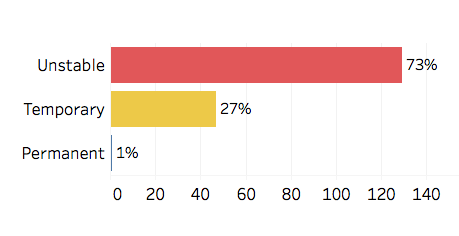
Since the program launched summer 2016, nearly three-quarters of the people welcomed to the Mission Navigation Center through the encampment resolution process wound up back on the streets after their stay, according to the last figures released by the Department of Homelessness and Supportive Housing in March.
“I appreciate this whole idea of getting everybody into the Nav Center and started on this path,” said Amy Farah Weiss, a homeless advocate who worked with Box City residents to make it a safer, more sanitary place to live. “But they just don’t have enough options for what happens after those 30 days.”
The clearing of Box City illustrates San Francisco’s ongoing struggle to contain the proliferation of the homeless camps that have become a pervasive part of its landscape in recent years, much to the dismay of residents and business owners. In 2016, complaints about the encampments logged by the public to San Francisco’s 311 customer service number swelled to upwards of 2,500 per month.
Over 4,300 homeless San Franciscans remain unsheltered each night, according to the latest estimates. The lack of affordable housing and overcrowded shelter system make it difficult to imagine the encampment phenomenon will disappear anytime soon.
Many homeless advocates fear that without long-term solutions in place, the city’s strategy to relocate camp dwellers, though well-intentioned, may do them more harm than good.
“It’s traumatizing,” Weiss says, for people to be sent back into the cold to start from scratch, with yet another place off limits.
[dropcap letter=”T”]he Encampment Resolution Team debuted August 2016 as the city’s new approach to address the homeless camp epidemic in a humane and effective way.
Previous efforts by the Mayor’s Office to clear the camps, namely the early 2016 sweeps of Division Street, received criticism for the way crews indiscriminately discarded people’s property. One man lost his wheelchair. Another his medication.
With nowhere to go, most had little choice but to reform their camps in smaller groups, some just a few blocks away.
The new initiative coordinated the efforts of the Department of Public Works, SFPD, and outreach workers from the Department of Homelessness to break that cycle. The idea was to target one camp at a time, and grant its entire population entry to the 75-bed Navigation Center on 1950 Mission Street.
The strength of the model, according to Randy Quezada, communications manager for the Department of Homelessness, is that it “meets people where they’re at.” Visitors can bring spouses and pets, and store some of their belongings. Services to help them get IDs, welfare, health screenings and drug counseling are done onsite. Case managers work one-on-one with guests to figure out the “next best steps” for their transition off the streets.
When the Mission Navigation Center opened its doors in March 2015, guests were offered an indefinite stay until permanent housing became available. An offer for a bed at the Navigation Center became known within the homeless community as the “golden ticket,” according to Kelley Cutler, a human rights organizer for the Coalition on Homelessness.
But by the time the Encampment Resolution Team began clearing camps last fall, the policy had switched to 30 days. Critics of the program point to this shift as a major flaw in the encampment resolution strategy. While most agree that indefinite stays are unsustainable given the city’s housing shortage, many say 30 days is not enough time for people make any real progress.
“After 30 days, where are folks supposed to go?”, Cutler said. “That’s when the city says it’s resolved. But, resolved for who?”
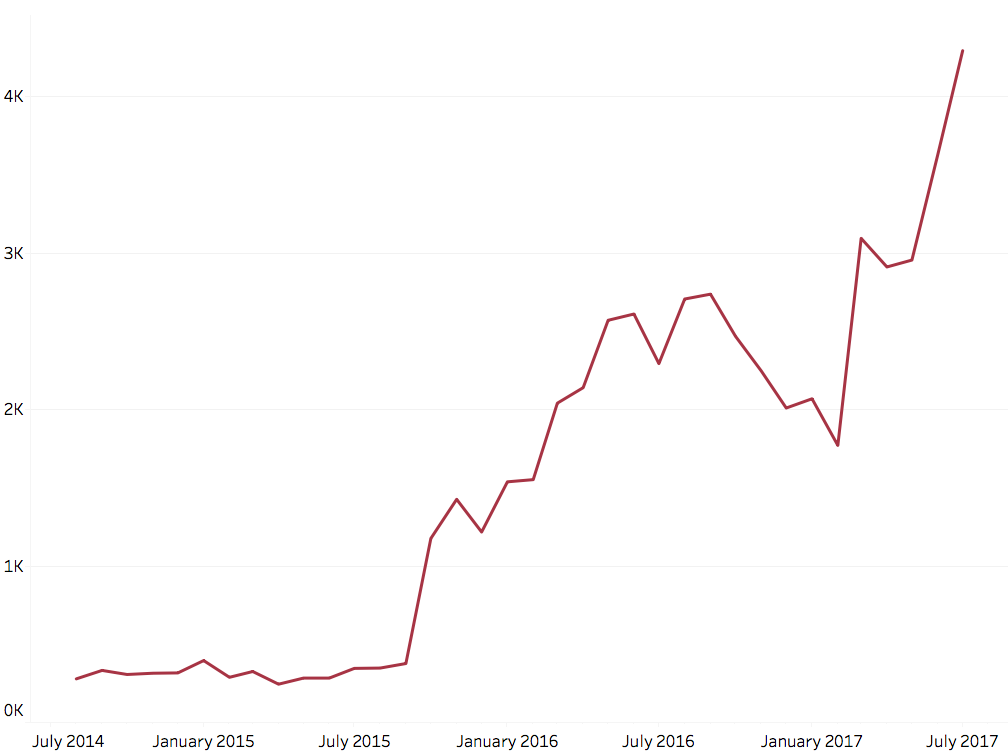
The discouraging numbers from the Department of Homelessness on encampment resolution outcomes back this up, as do the optics from the street.
After an initial dip in 311 complaints following the launch of the Encampment Resolution Team, they have soared to record highs. A database kept by the Department of Public Works to monitor encampments for its cleanup crews reveals that the number of active camps has remained static, hovering around 70, since the start of 2017.
Quezada cautions that numbers aren’t the whole story. He says it can take six or seven tries for a homeless person to reap the full benefits of the services available to them, and not to underestimate the power giving someone a break from the stress and health hazards of living on the streets.
“Even in cases where someone was out of the rain for 30 days, that’s better than being out there,” Quezada said.
[dropcap letter=”W”]hile the Department of Homelessness can’t release information about specific individuals, Weiss, who keeps in touch with the Box City cohort, estimates that all but five left the Mission Navigation Center without a place to go. The five that didn’t go back into the street were placed in homeless shelters or temporary housing.
In May, Weiss tracked over a dozen people to a new encampment that formed under the Bay Bridge on-ramp on Vermont street across from the upscale home furnishing stores of the Design District. The folks from Box City, it appeared, were determined to stay together.
“I have a lot of stress right now,” said Roland in a thick Filipino accent from the door of his new box on a blustery May afternoon. “Sometimes my head is like a tornado.”
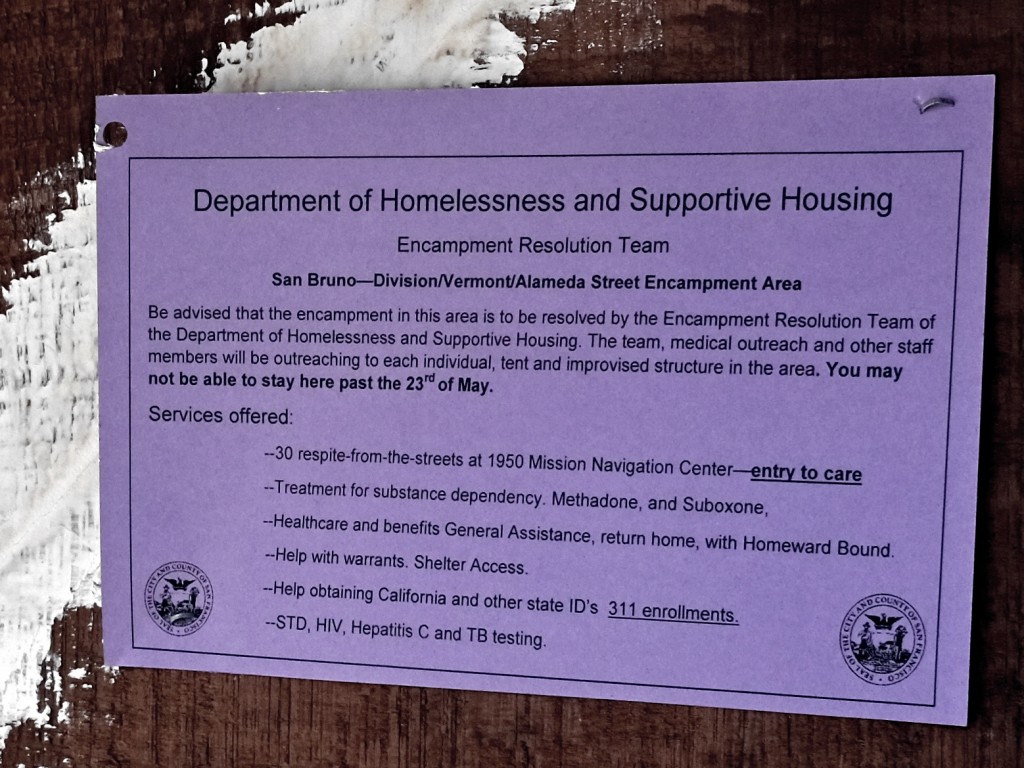
Roland’s sister is not doing well and he wants to visit her in the Philippines. But even if he had enough money for the flight, Roland doesn’t have his green card. At the Navigation Center, he was working to process it, but since he’s been out, he hasn’t followed up. Most of his time has been spent working on his box and collecting bottles for recycling.
To make matters worse, a few days earlier a familiar notice appeared, this time on purple card stock. The encampment, the note read, was being targeted for resolution.
On May 23, two days before Roland’s forty-fifth birthday, street sweepers, dumpsters and crowbars would arrive to take apart his new home.
This time, Roland decided, he wasn’t going to the Navigation Center only to be spit back out to build yet another box. Instead, Roland would find someplace else to camp.
Kelley Cutler says that Roland’s decision to reject another stay at the Navigation Center represents a phenomenon she sees in her homeless outreach work called “churn.” The term refers to the cycling of people back and forth between stability and crisis, and is the result of services that, while beneficial, are temporary in nature. The byproduct of churn, Cutler explains, is that over time “people start to lose hope.”
When he chained the door of his box shut on the morning of May 23, pushing it on caster wheels toward some unknown destination, Roland appeared to be one those people.
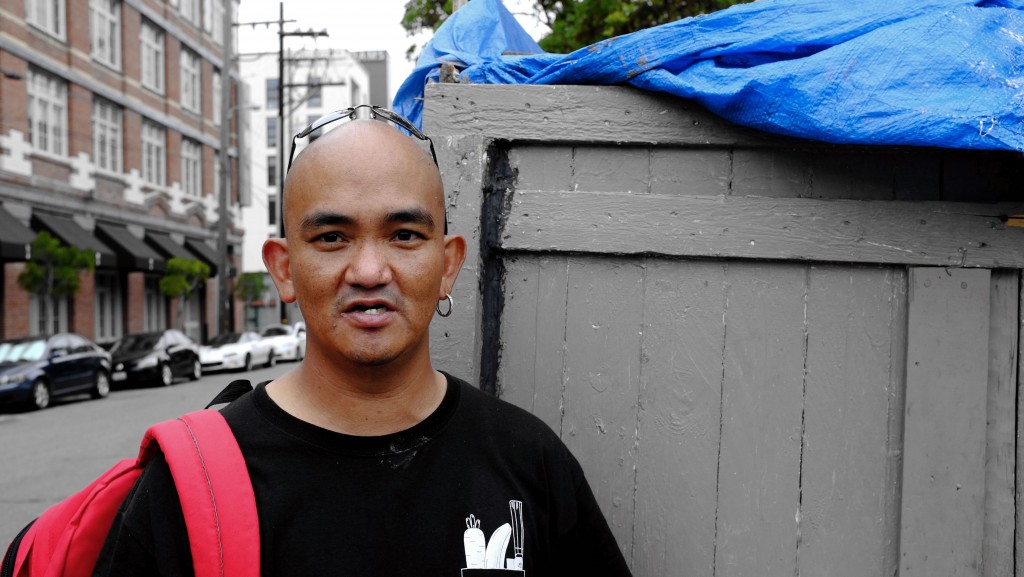
[dropcap letter=”F”]or all the criticism of the encampment resolution initiative, there is evidence it’s beneficial to some homeless San Franciscans. Roughly 25 percent of camp dwellers brought to the Mission Navigation Center are transitioned into single-room apartments at the Civic Center Hotel.
Civic Center beds are reserved for those who have been homeless for at least 13 years or have serious medical needs. Many of its guests are eventually placed in permanent housing.
Liz, Cheree and Ra Ra, who were part of the Box City cohort, have now been housed. And during his stay at the Mission Navigation Center, Ellie trained as an outreach worker for Hospitality House, a community-based program that offers supportive services to the homeless. Ellie is a volunteer, but is hoping to land a full-time paid position.
He was initially reluctant to give up his box for the Navigation Center, but was swayed by the chance to inspire hope in his friends on the streets.
“I said, ‘might as well try it,’ so I got something to show these people,” Ellie said. “If I succeed, they will follow. Right now, I’m almost there.”
Ellie, along with many homeless San Franciscans, praises the Mission Navigation Center for the resources and amenities it offers. He just wishes there were more of them.
That may be changing.
Two new Navigation Centers opened this past summer, and in May the city received a $100 million pledge from a charity organization called Tipping Point to fund solutions for homelessness. While the plans for the funds are still uncertain, many suspect the money will be used to increase the number of supportive housing units or expand the Navigation Center network.
More beds would mean less people on the street and longer stays at the centers.
Still, Amy Farah Weiss worries that for the foreseeable future, the demand for shelter and housing will far outweigh San Francisco’s limited supply. The total number of beds across the four Navigation Centers is about 350, and leases are temporary.
San Francisco’s 70 active homeless encampments as of August 2017 mapped using data obtained from the San Francisco Department of Public Works. (Peter Arcuni/Peninsula Press)
Through her non-profit, the Saint Francis Homelessness Challenge, Weiss is prototyping a micro shelter that meets RV safety standards. She says the structures could potentially give people a place to go after they leave the Navigation Center, while they keep working with the Encampment Resolution Team to find permanent exits off the streets.
So far, San Francisco officials have been reluctant to sanction encampments of any type, fearing it would set a bad precedent and do little to quell the increasing outcry from residents and business owners. What everyone seems to agree on is that the camps, as they continue to flood the sidewalks of San Francisco, need to be addressed.
“Tents and encampments as they are right now are untenable,” Weiss said. What the solution is, like the fate of many encampment dwellers, remains up in the air.
